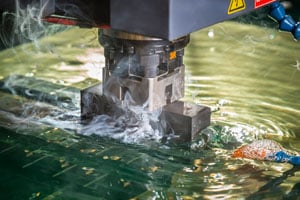Manufacturers use a wide range of different molding techniques to create different components and products, including blow molding, compression molding, extrusion molding, and rotational molding. Injection molding is a popular, versatile, and cost-effective method for producing plastic goods. A heated liquid resin is injected into a mold at high speeds so it fills the entirety of the mold (including any crevices or complex shapes). There, it cools and cures into a hardened plastic form before being ejected for finishing, packaging, and shipping. This process can be used with high-volume and low-volume orders of goods varying in size and complexity.

Design and Build Considerations for Custom Molds
Before injection molding can commence, manufacturers need to create a custom mold for the product, addressing the fundamental question of how to make plastic molds. This process focuses on four main considerations:
- The part design: Mold manufacturers will need to consider the size, dimensionality, and complexity of the product.
- Production quantity: How many parts you anticipate making is important. Molds can feature multiple cavities of basic products to produce many products at once. Molds can also be made from lighter and cheaper materials for low-volume orders and more durable and potentially pricier materials for high-volume production.
- Part material: The mold will need particular design features based on the chosen plastic or resin for the products.
- Budget: Consider the total budget available for tooling, which will dictate the quality of the mold material and whether it will be a mold for single parts or multiple units.
Resin Selection Guide
There are multiple different resins available for use in injection molded products, and each formula will have unique characteristics that affect both the production process and the finished product. There are two broad categories of production materials:
- Thermosets: After heating, curing, and cooling these materials into a set shape, their physical composition is permanently chemically altered. They cannot be reused or returned to their original form. There are multiple polymer materials that fall under the umbrella of thermoset. Popular options include epoxy, polyamide, polyester, polyurethane, silicone, and vinyl ester.
- Thermoplastics: These materials can be reheated and melted. One key advantage of thermoplastics is that excess material can be repurposed for future production orders. Thermoplastics are also easier to use because the injection molding process starts by heating small pellets of resin or powdered resin into a fluid.
Manufacturers can select their preferred material based on the individual properties of the material once it's cured, the ease of use during the manufacturing process, and the price. Other considerations can include regulatory compliance. For example, plastic goods used in tangent with consumable or cosmetic goods will need to be food-grade, while other plastic goods are less tightly regulated.
Another common consideration, especially in today's market, is the availability of the product. Having multiple sources for your preferred type of resin will make your supply chain more secure during peak seasons or global disruptions.
Other Tips to Consider When Building a Custom Plastic Product Mold
The type of mold and the resin material for the product are two of the top considerations for any plastic production project. However, factors ranging from labor availability to seasonal manufacturing demand can affect the profitability of the project. Some best practices to consider are:
- Work with a reliable manufacturer: Choose a plastics injection molding organization that has a long history of reliability and expertise. Ideally, you'll find a partner that offers product design support, mold making, and injection molding services.
- Consider where your mold is made: Mold suppliers can be found globally — from the United States to Portugal to China. Opting for a supplier that also manufactures the parts offers distinct benefits, including sole source accountability and a quicker transition from concept to production.
- Be flexible: Consider different materials, molding options, and other engineering concessions that can make your product as manufacturable as possible. Injection molding specialists can recommend changes in material and design elements that make manufacturing simpler and more cost-effective without compromising the quality of the product.
Contact the Custom Plastic Molding Experts at the Rodon Group Today
Injection molding is a versatile manufacturing process that can accommodate a wide range of designs, materials, and production constraints to create high-quality products. At The Rodon Group, we specialize in injection molding and a host of support services built to create your products at scale. Reach out today to learn more or to request a quote to start your order.









Comments